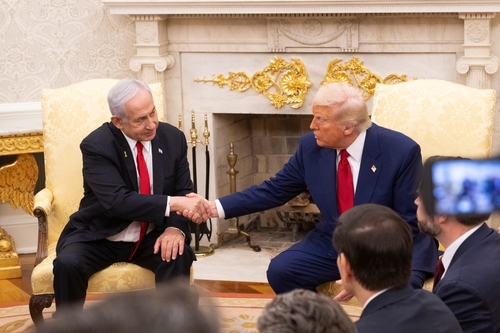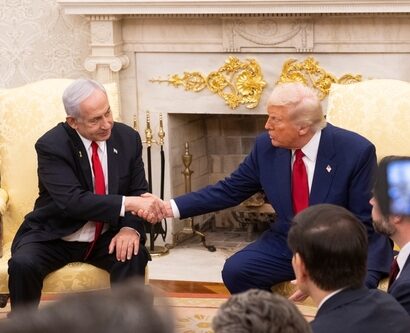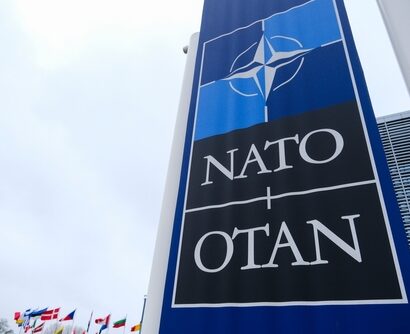Abstract: This article examines the causes of the Israeli–Palestinian and broader Israeli–Arab conflict by analysing the historical, moral, and political dimensions of both Jewish/Israeli and Arab positions. On the Israeli side, it explores the evolution of Zionism and Revisionist Zionism into a doctrine aimed at securing Israeli control over Palestine west of the Jordan River and reinforcing American–Israeli influence in the Middle East. On the Arab side, it contrasts the conflict-resolution approaches of the Moderate Sunni states and the predominantly Shia-led ‘Axis of Resistance’, focusing on four pivotal milestones: the 1948 Nakba, the rise and decline of pan-Arabism, the 1979 Camp David Agreement, and the 2002 Arab Peace Initiative (Beirut Declaration).
Problem statement: Why has the Israeli–Arab conflict resisted any lasting political or diplomatic solution?
So what?: Resolving the Middle East conundrum requires a negotiated settlement involving both Israel and the United States. There are two strategic scenarios:
(1) Pax Hebraica—Israel, supported by the United States, consolidates control over Palestine, expands normalisation with Arab states, and asserts regional dominance;
(2) Gathering the Arab Lands—a renewed pan-Arab movement, potentially led by Saudi Arabia, seeks to restore Arab solidarity and reverse the legacy of Sykes–Picot.

Source: shutterstock.com/noamgalai
The Conflict, Sunni and Shia
The four milestones in modern Arab history, as described above, primarily involved the Sunni leaders, particularly in Egypt—a country that, since the era of the Khedive Muhammad Ali, and until recently, has held a leading position in the Arab World. Nevertheless, at the level of implementation, lofty rhetoric has, broadly speaking, faded into the background.
The Axis of Resistance, predominantly Shi’a while often more spectacular, has proven no more effective. It has been significantly weakened, and its driving force, Iran, has chronically oscillated between revolutionary ideology and geopolitical caution, caught between the constant Israeli threat of devastating strikes and mounting international pressure over its nuclear programme.
The outcome of the 14-day war of June 2025 remains ambiguous. On the one hand, the Israeli-U.S. massive strikes appear to have seriously degraded Iran’s political and military capabilities. On the other hand, the Tandem failed to achieve its overarching goal of regime change.
The outcome of the 14-day war of June 2025 remains ambiguous.
As for Syria, Bashar al-Assad lacked both the political acumen and the resoluteness of his father. The fact that his regime endured for about a quarter of a century, particularly after the onset of the 2011 turmoil, is attributable mainly to his allies: Iran, Russia, and the military interventions of Hezbollah. However, with Iran and Russia weakened, Hezbollah effectively obliterated, and Bashar al-Assad’s regime collapsed.
Hezbollah, the long-time formidable foe of Israel and a major political player in Lebanon, collapsed under the pressure of sophisticated Israeli intelligence operations and the targeted, consistent assassinations of its top political leadership. Among them was Secretary General Hassan Nasrallah, a charismatic figure who had combined the outstanding qualities of both a religious and national leader.
Objectively, these developments have played into Prime Minister Netanyahu’s hands, opening new opportunities to pursue his own (Revisionist Zionism’s) ambitions for Israeli dominance over Palestine and, more broadly, the Middle East.
In the context of Israel’s ambitions over Palestine, it is worth referring to a statement by UN Special Rapporteur Francesca Albanese: “The ambition for a “Greater Israel (Eretz Yisrael) and the occupied Palestinian territory has been a long-standing goal since the very inception of the Zionist project and before Israel existed”. [35] Furthermore, she highlights the 2018 Nation State Law, which “asserted exclusive Jewish sovereignty over “Eretz Yisrael” and “Jewish settlement” in that area as national priority” and underlines that “On 28 December 2022, the current Government of Israel announced its plan to expand the colonies in the West Bank and aggressively advanced substantial land confiscation and settlement expansion”.[36]
To consolidate control over Palestine west of the Jordan River, the Israeli government has relied on coercive policies: maintaining a blockade and repeated military campaigns in Gaza that human rights groups describe as collective punishment, while simultaneously expanding Jewish settlements in the West Bank, which the UN classifies as occupied Palestinian territory.
Thus, there is undeniable evidence of Israeli actions aimed at asserting its authority over both Gaza and the West Bank. However, the Jewish state’s broader regional ambitions appear far more sophisticated—and often concealed beneath a veil of demagogy.
Pax Hebraica
The Tandem’s ultimate goal is to establish dominance in the Middle East. This objective is pursued by promoting Pax Hebraica, a regional security framework within which the states of the region would finally overcome the so-called ‘Palestinian complex’. Within this framework, they would feel free to develop political, economic, and cultural ties based on mutual interests under the Tandem’s auspices. The Abraham Accords have emerged as a key instrument in advancing the Tandem’s geostrategic aims and laying the groundwork for shaping this envisioned regional order.
The Tandem’s ultimate goal is to establish dominance in the Middle East.
The Abraham Accords
The Abraham Accords were a series of normalisation agreements signed in 2020 between Israel and several Arab states (Bahrain, Morocco, Sudan, and the United Arab Emirates) under the patronage of the U.S.
Abraham Accords—The Name
The name of the Abraham Accords is perceived as highlighting the supposed brotherly ties between Jews and Arabs. It may, however, have a quite different interpretation. From a Jewish standpoint, naming the accords after Abraham may subtly suggest that they are intended to pave the way for taking possession of the Promised Land, or otherwise, Bilad al-Sham, as Arabs have traditionally referred to the territories roughly encompassing Mandatory Palestine, Jordan, Syria, and Lebanon.
Abraham Accords—The Essence
The Abraham Accords Declaration, a generic document framing the subsequent bilateral agreements, invoke noble ideals—peace, prosperity, human dignity, religious freedom, and a shared “vision of peace, security and prosperity in the Middle East and around the world”. The bilateral accords themselves offer a variation on this theme of peace, prosperity, and friendly relations in the Middle East.[37]
After decades of hostility and human suffering, formerly conflicting Israelis and Arabs finally agreed to mutual recognition of one another, live in peace, and cultivate comprehensive ties. However, the Abraham Accords make no mention of Palestine, while bilateral agreements reduce this cornerstone issue to mere token references. In effect, signatories have abandoned the Palestinian cause—the foundational element of Arab unity and a long-standing source of collective Arab identity.
Abraham Accords—The Follow-Up
Several key countries have so far not joined the Abraham Accords—foremost among them Saudi Arabia, Syria, and Lebanon. To bring them on board, the Tandem may resort to one of two approaches: political/diplomatic or political/military. In the case of Saudi Arabia and Lebanon, the matter is to be addressed through political/diplomatic means. In the case of Syria, both approaches may be applicable depending on the specific circumstances.
Saudi Arabia
For America, an Abraham Accords agreement between Israel and Saudi Arabia offers a way to hit several targets with one shot. First, the accession of a major regional player would maximise the chances of establishing a Tandem-dominated security arrangement in the region. Second, it would open opportunities for generating significant profits for major American and Saudi business interests.[38] Last but not least, thanks to the Abraham Accords, the US will be able to finally resolve a persistent foreign policy challenge: reinforcing its close relationship with Israel while maintaining strong cooperation with the Arab world.
Lebanon
On July 07, 2025, Thomas Barrack, U.S. Special Envoy for Syria, met with Lebanese President Joseph Aoun to seek an official response to the American proposal aimed at disarming Hezbollah. While the details of the response have not been disclosed, after the meeting, the Special Envoy expressed that he was “unbelievably satisfied” with Lebanon’s reaction.[39] He also conveyed to the Lebanese counterpart President Trump’s willingness to “help Lebanon prosper”, adding that it was time to change the region. More importantly, referring to the dialogue between Israel and Syria, the Barrack urged Lebanon to follow suit.[40]
Calling on Lebanon to engage in dialogue with Israel, coupled with the emphasis that the region “needed change”, could be translated from American diplomatic Volapük as an ill-disguised appeal to launch negotiations on Lebanon’s accession to the Abraham Accords.
President Aoun has publicly stated that any peaceful settlement must be tied to the withdrawal of Israeli troops from Lebanon’s internationally recognised territories. In a recent speech on the occasion of Army Day, he reiterated this position. He disclosed some details of the ongoing negotiations with the U.S. Another important point he raised was the urgency of Hezbollah’s disarmament and the transfer of its weapons to the Lebanese army.[41]
Syria
During his visit to Saudi Arabia in May 2025, President Trump met with Syria’s transitional president, Ahmad al-Sharaa. According to a statement by the White House Press Secretary posted on X, the American side urged the Syrian leader to sign onto the Abraham Accords with Israel.[42]
However, a key stumbling block in Syrian-Israeli relations remains Syria’s demand for the complete withdrawal of Israeli forces from the Golan Heights. Conversely, following the fall of Bashar al-Assad’s regime, Israel has expanded its control beyond the Golan Heights and launched a series of military operations ostensibly aimed at protecting the Druze community in the al-Sweida region.
At the extraordinary Summit of the League of Arab States held in Cairo in March 2025, Ahmad al-Sharaa delivered a bold speech, declaring: “Uprooting the Palestinian people from their land cannot be accepted, and it is time for all of us as Arabs to stand against these schemes. […] Arab countries must unite in their positions and take responsibility towards the Palestinian people”.[43]
In the Syrian context, one must also reckon with Turkish influence, which extends beyond political, military, and diplomatic domains. One could argue that President Erdogan aspires to reshape the region along the lines of the Ottoman imperial legacy. This dimension would introduce an additional layer of complexity to the Syrian equation, as Türkiye’s ambitions are in clear conflict with the Tandem’s strategic objective of establishing Pax Hebraica through the Abraham Accords. One can anticipate that this geopolitical confrontation could either escalate into open military clashes between Israel and Türkiye or result in a tacit understanding leading to the partition of Syria into respective spheres of influence.
The Way Ahead
Dismantling the conflict-prone world system of the Middle East would require a bold political initiative. A leading Arab state has to assume responsibility for transcending the Sykes-Picot boundaries to consolidate unity within the Arab ranks. Saudi Arabia appears to possess all the political prerequisites for assuming such a leadership role. As Jan Busse and Anna Reuß have rightly observed, since the 1970s, the geopolitical centre of gravity in the Arab world has shifted toward the Arabian Peninsula.[44] Consequently, Saudi Arabia has assumed an increasingly significant role in shaping regional policy. In addition to its vast material resources, the Kingdom’s development programme, Vision 2030, adopted in 2016, aims to further this transformation. If fully realised, the initiative could dismantle the long-standing stereotype of Saudi Arabia as merely an oil-dependent state by diversifying its economy and modernising its social fabric. Even more significantly, Saudi Arabia holds immense spiritual capital and occupies a central position among Arab nations.
A leading Arab state has to assume responsibility for transcending the Sykes-Picot boundaries to consolidate unity within the Arab ranks.
Thus, Saudi Arabia today stands at a crossroads: whether to pursue rapprochement with the Tandem by joining the Abraham Accords and acquiescing to its regional supremacy, or to choose a confrontational path—one aimed at defending, beyond the Palestinian cause, Arab unity and dignity.
There are conflicting signals. On the one hand, President Trump’s recent visit to Riyadh points toward the first option.[45] On the other hand, Saudi Arabia, together with France, initiated a UN High-level Conference on Palestine aimed at advancing the two-state solution.[46] In this context, the trajectory of geopolitical developments in the Middle East, particularly regarding the Palestinian question, hinges significantly on the choices made by the Saudi leadership.
Latest Developments
The Knesset Motion and Netanyahu’s Interview with i24 News
On July 23, 2025, the Knesset approved a motion in favour of annexing the West Bank, calling on the government to “apply Israeli sovereignty, law, judgment and administration to all areas of Jewish settlement of all kinds in Judea, Samaria and the Jordan Valley”.[47] In doing so, the Knesset stressed that the West Bank constitutes “an inseparable part of the Land of Israel, the natural, historical, and legal right of the Land of Israel”.[48]
Palestinian President’s deputy, Hussein al-Sheikh, condemned the motion as a “dangerous escalation that undermines the prospects for peace, stability and the two-state solution”.[49] For the Israeli leadership, however, peace and stability mean only one thing: uncontested sovereignty over Gaza and the West Bank.
This stance was once again confirmed during the Israeli Prime Minister’s interview with the Jewish news agency i24 News on August 12, 2025, when he stated that he felt very connected to the vision of Greater Israel, pointing to territories in Egypt, Jordan, Syria, and Lebanon.[50] It is evident that Israel has never abandoned the idea of restoring dominance over the Promised Land, and has never been closer to its realisation.
The High-Level International Conference for the Peaceful Settlement of the Question of Palestine and the Implementation of the Two-State Solution
For several months, France and Saudi Arabia had advocated for a high-level event under the UN umbrella to articulate a unified position among member states aimed at ending the violence in the Gaza Strip and promoting a two-state solution. This could create the conditions for ending the conflict and for establishing a just and lasting peace.[51]
A High-level International Conference for the Peaceful Settlement of the Question of Palestine and the Implementation of the Two-State Solution took place on 28-30 July in New York. Its general debate featured more than 120 speakers, who overwhelmingly supported a two-state solution and expressed “high expectations that the Conference would generate tangible momentum towards realising that vision”.[52]
The Conference’s distinguishing trait, compared with similar events, was its magnitude – reflected in the joint Arab-Western initiative, the active participation of UN member states, and their determination to take bold steps toward the definitive resolution of the conflict. The worsening humanitarian situation in the Gaza Strip underscored that such an effort, though of uncertain outcome, had to be undertaken.
The Conference concluded with the adoption of the “New York Declaration on the Peaceful Settlement of the Question of Palestine and the Implementation of the Two-State Solution”.[53]
However, despite the Conference’s lofty ambition, peace can only be achieved through a negotiated and mutually acceptable agreement, including both Israel and the United States. Unfortunately, Israel flatly rejected it, and the U.S. sharply criticised the event, calling it “unproductive and ill-timed”.[54]
Nevertheless, Saudi Arabia, Syria, and Lebanon would hardly be able to conclude the Abraham Accords with Israel without including a strongly articulated provision on Palestine and the Two-State solution. This, in turn, would make it impossible for Israel to sign any such agreement; for now, peace seems out of reach.
Saudi Arabia, Syria, and Lebanon would hardly be able to conclude the Abraham Accords with Israel without including a strongly articulated provision on Palestine and the Two-State solution.
Conclusion
At this juncture, two mutually opposing scenarios may be envisaged as plausible paths forward.
Scenario 1- Pax Hebraica
Backed by America’s powerful military and political support, Israel proceeds—under the harsh criticism and rhetorical declarations by the international community—to devastate Gaza, ultimately eliminating Hamas and deporting the civilian population. In the West Bank, a similar outcome unfolds, albeit through different means: instead of large-scale military operations, a process of gradual settlement expansion and administrative integration consolidates Israel’s control.
To the east of the Jordan River—and across broader territories traditionally included in the Jewish interpretation of the Promised Land—the Abraham Accords are extended to encompass Saudi Arabia, Syria, Lebanon, and other states. The result is the emergence of a regional security, political, and economic complex under the tight supervision of the Israeli-American Tandem.
This calculus may yet be disrupted by the denunciation of the Abraham Accords by those Arab states that have already concluded them, as well as by others that renounce any intention to join. Another possibility for debanking in that scenario may lie with Turkey, given its imperial ambitions over the former possessions of the Ottoman Empire, and, to a lesser extent, with Iran, which, despite being significantly weakened, may still manage to reassert itself.
Scenario 2 – Gathering the Arab Lands
The aspiration toward Arab unity—most likely spearheaded by a leading power such as Saudi Arabia—gathers momentum and begins to take shape, potentially evolving into a political-military alliance or even a confederation. Such a development, although seemingly implausible at present, would constitute a profound geopolitical shift—one that would require dismantling the Sykes-Picot framework and redefining the political geography of the modern Arab world, thereby enshrining the spirit of Arabism.
Dr. Vahram Abadjian is an independent international affairs analyst. His research interests encompass several regions of the globe, with a particular focus on the Middle East and North Africa, where he has been actively engaged in Iraq, Lebanon, Jordan, Yemen, and Tunisia. He holds a PhD in Political Science from the University of Vienna. The views contained in this article are the author’s alone and do not represent the views of The Defence Horizon Journal.
[35] United Nations, “Situation of Human Rights in the Palestinian Territories Occupied since 1967: Note by the Secretary-General,” A/79/384, October 01, 2024.
[36] United Nations, Situation of Human Rights, A/79/384.
[37] State of Israel, The Abraham Accords (2017–2021 Archived Content), U.S. Department of State, last accessed July 19, 2025, https://2017-2021.state.gov/the-abraham-accords/?safe=1.
[38] Suffices to mention that during President Trump’s visit, Saudi Arabia announced its $600 billion commitment to invest in the United States. See: Fact Sheet: President Donald J. Trump Secures Historic $600 Billion Investment Commitment in Saudi Arabia. The White House, May 13, 2025, last accessed July 20, 2025,
[39] Reuters, “US Special Envoy ‘Satisfied’ with Lebanon Reply to US Roadmap to Disarm Hezbollah,” July 07, 2025, https://www.reuters.com/world/middle-east/us-special-envoy-satisfied-with-lebanon-reply-us-roadmap-disarm-hezbollah-2025-07-07/?utm_source=chatgpt.com.
[40] Nada Homsi, “US Envoy ‘Unbelievably Satisfied’ with Lebanese Response to Proposal on Hezbollah Disarmament,” The National, News MENA, July 07, 2025, last accessed July 20, 2025, https://www.thenationalnews.com/news/mena/2025/07/07/us-envoy-thomas-barrack-in-beirut-to-press-for-hezbollah-disarmament.
[41] National News Agency (NNA), “President Aoun Marking Army Day Calls for Exclusive Army Control of Weapons, Unveils Roadmap for National Sovereignty and Stability,” July 31, 2025, https://www.nna-leb.gov.lb/en/politics/798613/president-aoun-marking-army-day-calls-for-exclusiv.
[42] Karoline Leavitt (@PressSec), “Post on X (formerly Twitter),” May 14, 2025.
[43] Syria Times, “President Al-Sharaa: The Call for Forced Displacement of the Palestinians from Their Land a Stain on Humanity,” March 04, 2025, last accessed July 21, 2025, http://syriatimes.sy/president-al-sharaa-the-call-for-forced-displacement-of-the-palestinians-from-their-land-a-stain-on-humanity/.
[44] Jan Busse and Anna Reuß, “‘Abraham Accords’: Israel und die Arabische Halbinsel,” in Die Arabische Halbinsel: Geographie und Politik, ed. Thomas Demmelhuber and Nadine Scharfenort (Berlin: Springer, 2025), 284–85.
[45] Reuters, “Saudi Arabia Pledges $600 Billion Investment in U.S. Projects during Trump Visit,” May 13, 2025, https://www.reuters.com/world/us-trump-saudi-crown-prince-sign-economic-partnership-agreement-2025-05-13/?utm_source=chatgpt.com.
[46] Michelle Nichols, “Saudi Arabia, France Seek Support for Declaration on Two-State Solution between Israel, Palestinians,” Reuters, July 30, 2025, https://www.reuters.com/world/middle-east/saudi-arabia-france-seek-support-declaration-two-state-solution-between-israel-2025-07-29/?utm_source=chatgpt.com.
[47] Times of Israel, “Knesset Votes 71–13 for Non-Binding Motion Calling to Annex West Bank,” July 23, 2025, last accessed July 25, 2025, https://www.timesofisrael.com/knesset-votes-71-13-for-non-binding-motion-calling-to-annex-west-bank.
[48] Sam Sokol and Toi Staff, “Knesset Votes 71–13 for Non-Binding Motion Calling to Annex West Bank,” The Times of Israel, July 23, 2025.
[49] Sokol and Toi Staff, “Knesset Votes 71–13”.
[50] The Times of Israel, “Netanyahu Says He’s on a ‘Historic and Spiritual Mission,’ Also Feels a Connection to Vision of a Greater Israel,” August 12, 2025, https://www.timesofisrael.com/liveblog_entry/netanyahu-says-hes-on-a-historic-and-spiritual-mission-endorses-vision-of-greater-israel/.
[51] Suffices to mention that during President Trump’s visit, Saudi Arabia announced its $600 billion commitment to invest in the United States. See: Fact Sheet: President Donald J. Trump Secures Historic $600 Billion Investment Commitment in Saudi Arabia, The White House, May 13, 2025, last accessed 20 July 2025,
[52] United Nations, “High-Level Conference on Two-State Solution Concludes General Debate, Will Reconvene to Consider Outcome Document,” UN Press Release, July 30, 2025, last accessed August 03, 2025, https://press.un.org/en/2025/pal2250.doc.htm.
[53] United Nations, New York Declaration on the Peaceful Settlement of the Question of Palestine and the Implementation of the Two-State Solution, Adopted at the High-Level International Conference on Palestine, New York, July 30, 2025, last accessed August 04, 2025, https://press.un.org/en/2025/pal2250.doc.htm.
[54] Associated Press. “UN Conference Backs Two-State Solution, Calls on Israel to Commit to a Palestinian State. ” July 30, 2025. Accessed August 4, 2025. https://apnews. com/article/un-israel-palestinians-twostate-gaza-declaration-conflict-7373306d09d7efbb634dab53be711586.





